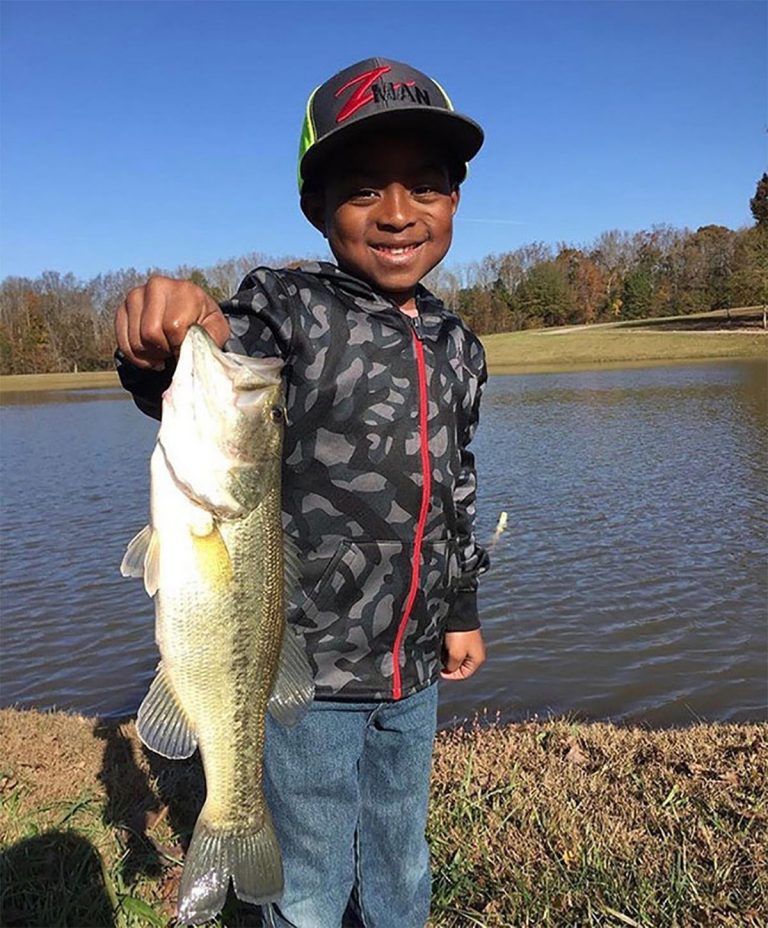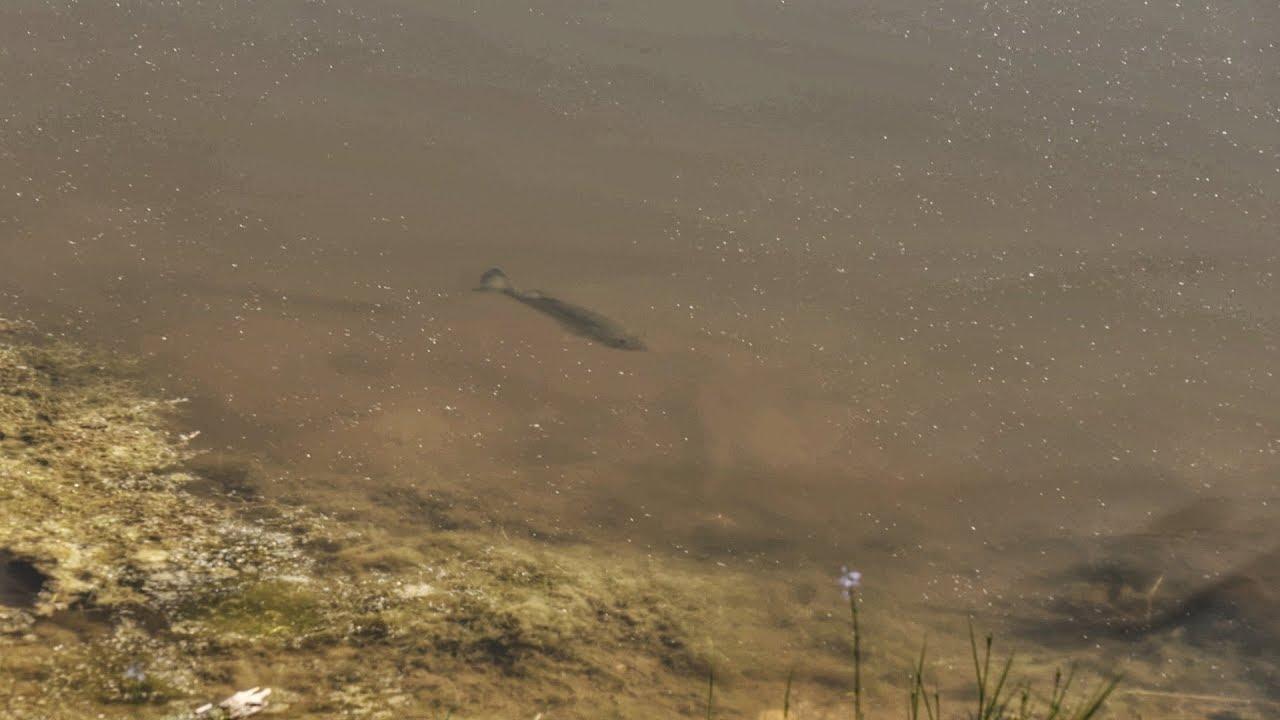It’s the day before a major FLW Tour event, and rising star Brian Latimer is fresh off a full day of prefishing. He’s tired, more than a little frazzled and has a meeting to attend in just a few hours. You might imagine an in-demand angler like “B. Lat” would want to kick back, de-stress, or maybe grab a nap.
Instead, the native South Carolinian heads right back to the water. This time, there’s no bass boat attached to his truck. No fancy tournament jersey on his back. No high-tech sonar, GPS or electric trolling motor to monkey with.
Latimer simply laces his sneakers and loads a backpack with a cold drink and a small tackle box. He snares a single rod and reel and quietly walks down to the grassy banks of a little pool of water he’s never fished in his life. Within the next hour, B. Lat’s friendly grin is back, having lipped enough largemouth bass to reset his frame of mind.
A good pond is probably closer than you think

“I love hitting up ponds,” admits the affable Latimer, winner of the 2019 FLW Tour event at Lake Seminole, Florida. “But growing up fishing with a father who was a tournament angler, I didn’t get into pond fishing until I was old enough to drive. I’d pick up maps of my area and discover a whole new world of fishing on these little lakes. Plenty of them still hide some pretty awesome bass fishing.”
Now married with a 7-year-old son, Latimer’s passion for fishing ponds on foot, as well as wading or kayaking small rivers and streams, hasn’t wavered. “My son Brevyn and I have a blast discovering small waters together. You never know what you’re going to catch. Each one of these little fisheries has some sort of surprise up its sleeve. I caught my personal best, double-digit bass at one of these ponds this past year, right in the heart of a big city.”
No matter where you live in the country, says Latimer, you’re likely surrounded by ponds, creeks or other small waters filled with fish. “Back in high school, we’d knock on a lot of doors asking for permission,” he recalls. “These days, it’s a little different. But even though folks are a bit less likely to let you on their property, there’s still only one way to do it if you’re in doubt about access: get permission or go somewhere else.”
Use satellite imaging to find untouched water

To find ponds in unfamiliar areas, Latimer calls up Google Earth on his phone, and zooms in on waterbodies with interesting potential. “Google Earth’s aerial views sometimes show you underwater structure, as well as inlets, boat docks, and the access points. If you’re still unsure whether the pond is open to public fishing, you can go to your county office and pick up a plat map, which indicates land ownership.
What B. Lat particularly loves about walking, wading or kayaking is that it lets him reach untouched water. “I can get to a lot of places and skinny water where anglers with bigger boats can’t put a lure,” he says. “A ton of nice fish can live in areas like this, whether it’s far up a little creek or even way up into the far reaches of a larger pond or lake. Same deal with a lot of small, non-descript ponds. They can be way down remote county roads or surrounded by condos, so a lot of anglers pass them by in favor of more obvious fishing spots. These are the places I like to explore first.”
The simplicity of pond fishing, says Latimer, provides a nice break from the pressure of big tournaments. “Great thing about a pond is you’re just dealing with the water that’s right in front of you. It forces you to focus on your presentation and simply figure out how to make bass bite. On a bigger lake, you often drive your boat to spots that fit the baits you want to throw. But when walking a pond, you bring a few of your favorite baits and focus on each cast and retrieve.”
Rely on high-percentage baits

For B-Lat, a small variety of all-star baits fill a pair of “sneak boxes,” each stowed neatly into a backpack, along with pliers, sunglasses and a few snacks. “I pack a lot of smaller finesse-style baits. Ned rigs are great, especially for kids, because they simply catch fish.
“One sweet pond bait and one of my son’s favorites is a Ned rig with a tiny spinner blade inserted into the tail. I like to use a mushroom jighead and Z-Man Finesse TRD with a TRD SpinZ tail spinner; the spinner gives the bait a little extra flash and vibration. Put it into the hands of any young angler, and they just about can’t fish it wrong-slowly hopped along bottom, dragged or dead-sticked, or even straight-retrieved like a spinnerbait. It’s a fish catcher everywhere we go.”
Other B-Lat pond bait essentials: “A few smaller Rat-L-Traps; they help cover water and find the sweet spots,” he adds. “Wacky rigged baits like the Hula StickZ are money; most pond fish haven’t seen a wacky rig before and they smash ’em. The TRD TicklerZ is the other Ned rig bait we throw a lot-and we throw a ton of Neds. A soft jerkbait like the 3.75-inch StreakZ rigged on a keel-weighted ChinlockZ hook scores, too.
“Anything weedless and weightless is perfect for kids. My son loves throwing topwater baits. The soft Pop ShadZ can be rigged weedless so it works cleanly over any type of cover. This bait keeps my son interested and tuned-in- even if the fish aren’t going- because it’s a visual thing.”
Rather than casting straight out into the pond, Latimer prefers to walk quietly and cast parallel to the bank.
“A lot of ponds lack underwater ledges, drops or other structure. The bank itself is often the best ambush point for bass to use, especially banks with a little lip or at least a 1-foot drop, rather than a gradual taper. I’ve caught some of my biggest pond bass a few feet off the bank. But if you’re loud or don’t take a low profile, you can spook a lot of these fish.”
5 quick tips

- Concentrate on the shady side of the pond, or where buildings or large trees create a shade edge.
- On hot days, fish ponds in the early morning, evening or at night.
- Use a longer 7- to 8-foot rod, which proper lures further and allow you to hold line above emergent vegetation or other obstructions while fishing from shore.
- Look for fish on any shallow cover, such as a fallen tree, dock or boulder. If the pond lacks cover, fish close to the deepest water-where a drop-off runs close to shore.
- Keep it simple and fun!
EDITOR’S NOTE: Article courtesy of Z-Man Fishing.

















